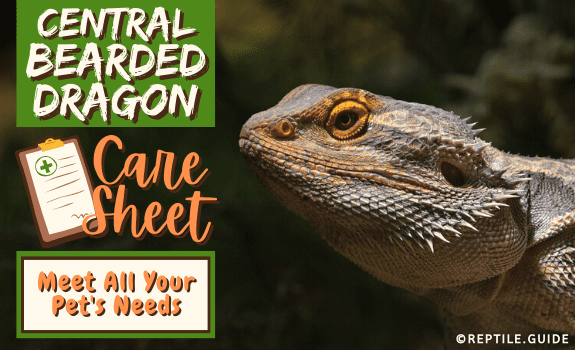The central, otherwise known as an inland, bearded dragon, Pogona viticceps, is one of the most popular and enjoyable reptile pets.
These interesting creatures, with their fleshy tongues, round pupils, and lateral spines, have a variety of interesting behaviors.
Head bobbing, glass surfing, and arm-waving are just a few of the behaviors that make them charming pets.
Studies have found that the occurrence of preventable diseases in captive bearded dragons can be worryingly high.
This pattern highlights the importance of knowing how best to care for your central bearded dragon.
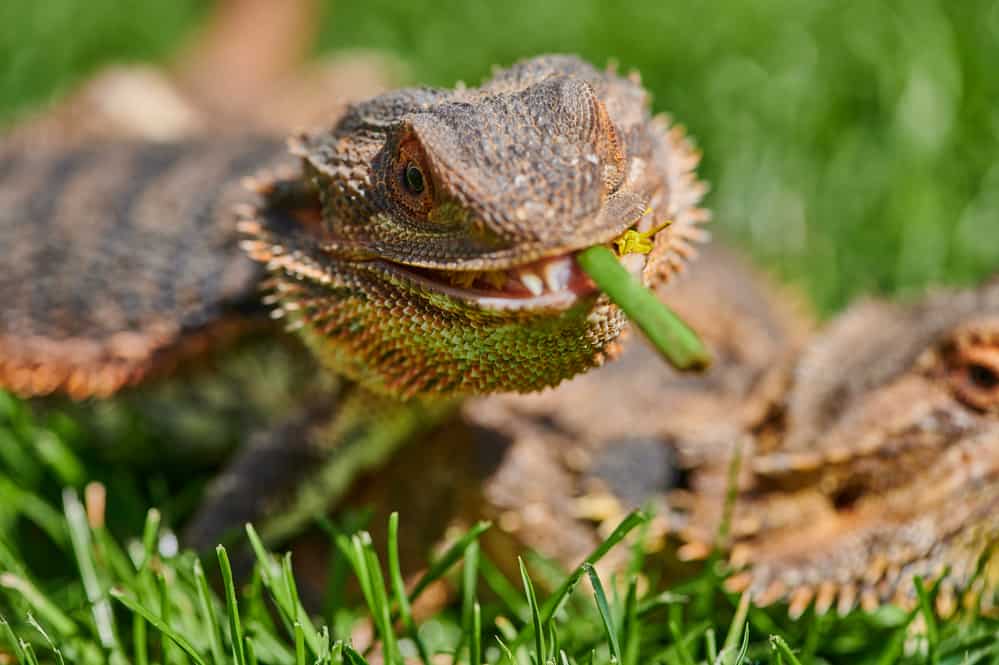
In This Article
What You’ll Learn About Central Bearded Dragons, AKA Inland Bearded Dragons
We’ve brought together all the most important points from the following aspects of central bearded dragon care and specificities, such as:
- Diet
- Handling
- Substrates
- Hides and decor
- Baby central bearded dragon specifities
- Factors affecting central bearded dragon price
- Central bearded dragon colors, lifespan, and size
- Enclosure parameters – temperature, humidity, lighting
- How to provide the best care for your bearded dragon pet
We discuss these topics for your use as a guide, along with veterinary advice from a specialist reptile veterinarian.
Central Bearded Dragon Price
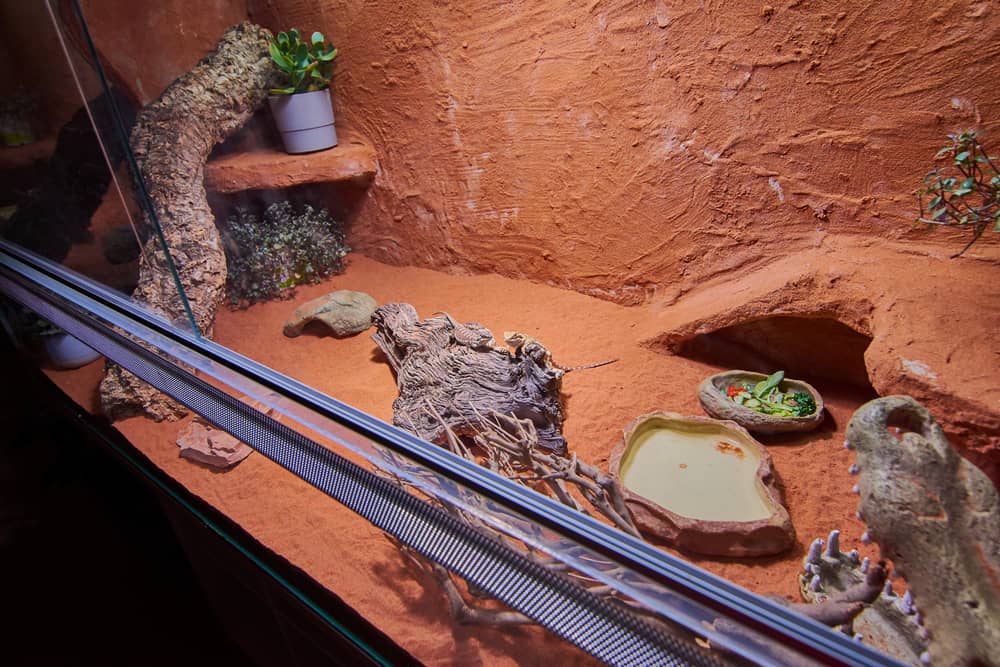
Potential bearded dragon owners must take all the above into account before buying a bearded dragon.
The cost of solely the bearded dragon varies, as is the case with all pets. Bearded dragon price depends on factors such as:
- Age
- Color
- Gender
- If purchased from a breeder or a pet store
- Type (morph or non-morph and how widely bred it is)
Taking the above into consideration, a potential buyer can expect to pay between $35 to $1000 per dragon.
Female individuals, especially those with interesting color morphs, can cost more because they are valuable during the breeding season after reaching sexual maturity.
Young bearded dragons cost less than older individuals, but it is worth noting that you won’t know their mating capabilities or final appearance until they stop growing.
If you buy your dragon from a pet store, chances are that it will cost less than from a breeder.
It is important to note that this initial lower price sadly can come at a cost for your pet.
Sometimes animals purchased from pet stores live in sub-optimal conditions.
Lizards are not everyone’s cup of tea; you can’t be sure that pet store workers know how to care for them properly.
Chances are that if you buy from a breeder, your dragon will be in a better health condition.
Breeders are usually more knowledgeable and experienced in lizard husbandry.
Another benefit of buying from a breeder is that they can answer any questions you have based on their experience, such as the appropriate food to give them.
In general, we would recommend a beginner to purchase a young bearded dragon directly from an experienced and reputable breeder.
You can read about our recommended breeders here.
Potential buyers of a bearded dragon must also take into account the following costs:
- Food
- Lighting
- Substrate
- Decorations
- The enclosure
- Climbing objects
- Heating elements
- Monthly energy bills
- Veterinary consultations
- Potential medication or treatment costs
Central Bearded Dragon Lifespan
Being aware of how long your bearded dragon will live is important. A central bearded dragon can live up to 10 to 15 years in captivity.
The prospect of having a dragon pet may seem exciting and manageable initially, but those feelings must last for the entirety of your pet’s life.
Potential owners of a central bearded dragon must be aware of the commitment they face.
In this article, you can read more about how mating occurs in this lizard species.
You’ll learn specifics, such as how a female buries her eggs, her ability to store sperm, and have eggs from multiple clutches in a nest box all after only one mating.
Central Bearded Dragon Size
An adult bearded dragon weighs from 12 to 21 ounces. Male individuals can grow between 16 to 24 inches and females from 12 to 20 inches.
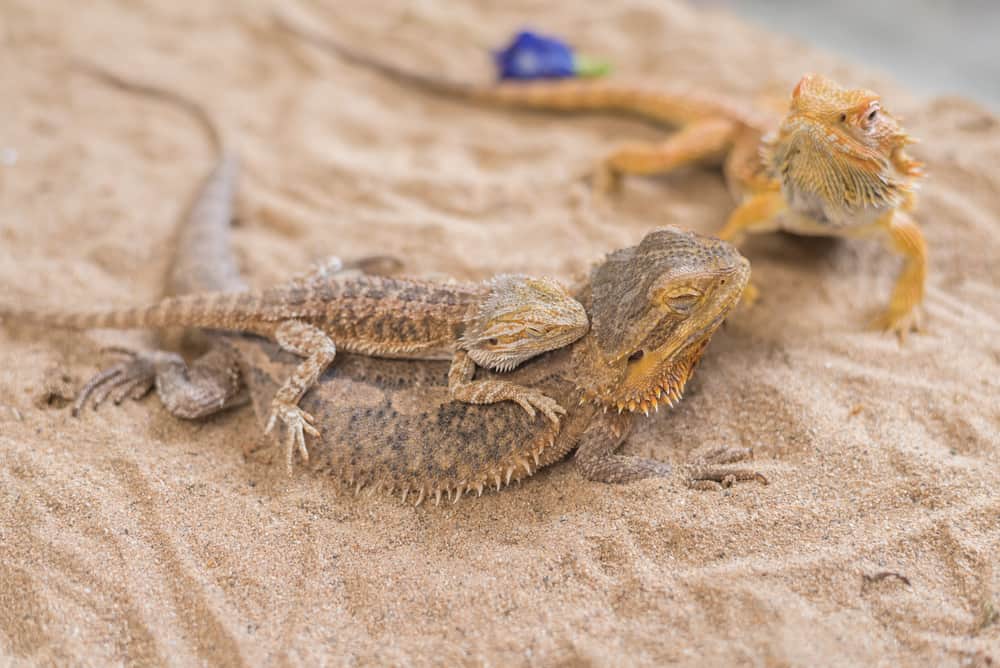
Central Bearded Dragon Colors
A central bearded dragon can come in many different colors, such as:
- tan
- red
- violet
- beige
- green
- brown
Fun Fact: The beard of a dragon will turn black when he is ready for mating.
You can read more about the particulars of a red-bearded dragon here. There are also lots of morphs of the central bearded dragon (Pogona vitticeps).
How to Care for Central Bearded Dragons
It’s reported that many health problems in bearded dragons are due to preventable illness from a husbandry perspective.
Maintaining the best care for your bearded dragon will minimize these risks and prevent avoidable veterinary costs.
We’ve summarised all the aspects of bearded dragon care for use as a guide, along with the advice of a specialist reptile veterinarian.
Diet

Younger lizards should eat a ration multiple times a day, consisting of half vegetation and half insects. These lizards also have a higher calcium requirement than older lizards.
Read more about how often to feed your bearded dragon according to its age.
Suitable insects, which must also be gut-loaded with calcium, include:
- locusts
- crickets
- silkworms
- waxworms
- mealworms
Examples of appropriate plant matter include:
- kale
- carrots
- squash
- spinach
- broccoli
- cabbage
- zucchini
It isn’t recommended to feed central or other species of bearded dragons fruit often because of their high sugar and water content. An example of this is watermelon.
You can, however, offer small rodents such as baby mice a couple of times each month. Here, you can read our complete food list for the bearded dragon species.
Provide water for bearded dragons in shallow containers they can climb into. If they don’t drink enough, they can become constipated.
Pro Tip: You can encourage your pet to drink by misting the enclosure.
If you’re looking for a reliable bearded dragon food and supplies online store, we recommend Chewy!
It is the most trusted and convenient online destination for reptile pet owners. Click here to save 30% on your first order.
I may receive a small commission if you purchase after clicking. This does NOT change what you pay or what I recommend.
It does help fund the research we put into the site, and I’m grateful for any support!
Handling
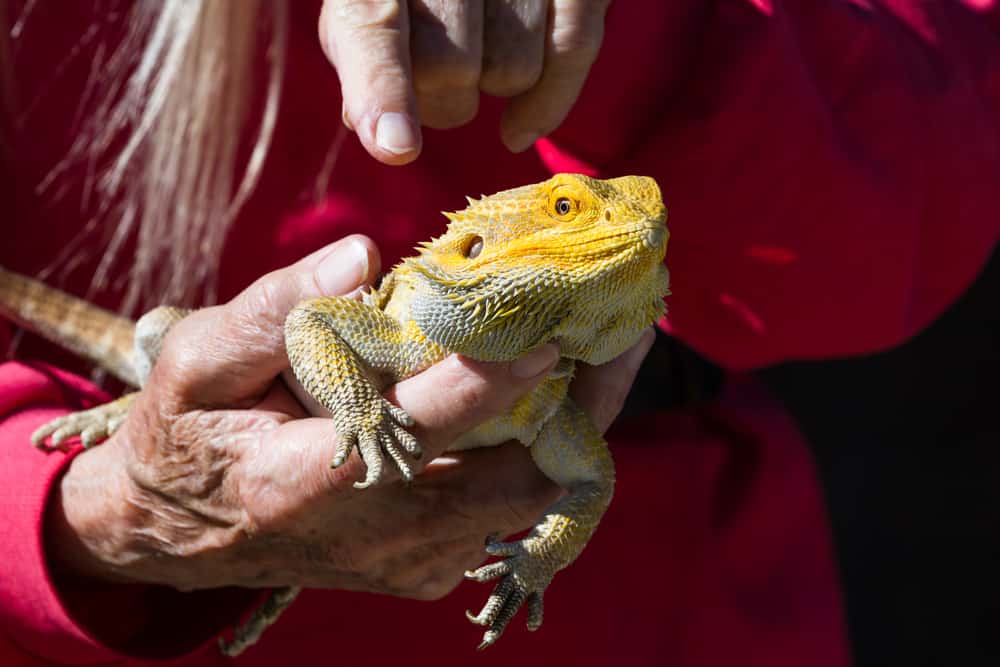
Here we have listed some things to note when handling these animals:
- Never turn them onto their back.
- Do not interrupt them if they are eating.
- Always wash your hands before and after.
- 15 minutes is a good handling time for these animals.
- Never grab their tail; they will see you as a potential predator.
- Always move your hand slowly towards them to ensure they don’t feel threatened.
- A black beard can indicate that they are stressed, and it’s probably time to call it a day.
- Never put them in high places as bearded dragon species may jump and injure themselves on landing.
- Avoid sudden movements; make sure that they are aware of your presence by talking to them beforehand.
Pro Tip: You can use treats to reward your bearded dragon during or after handling!
Behavior
In the wild, bearded dragons live between the east part of South Australia to the northern southeast.
Bearded dragons are a semi-arboreal species. In the wild, you can find them in sunny basking areas or residing in vegetation.
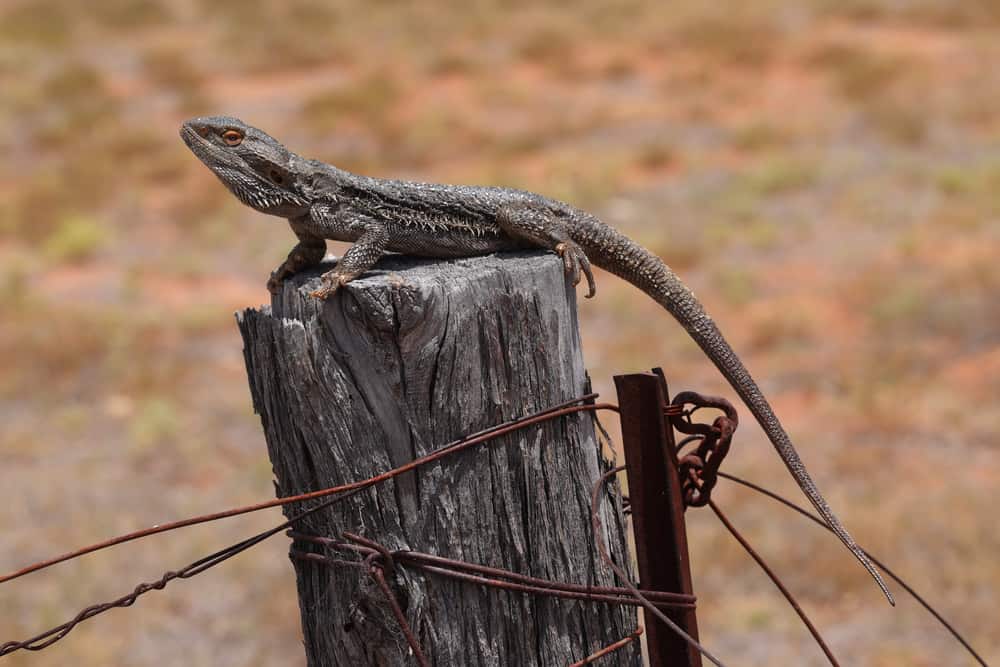
Bearded dragons also use underground burrows to hide from the heat and potential predators.
Their conservation status in the wild is of least concern; they are not considered a threatened species.
Arm waving is a behavior bearded dragons express to show submission.
Fun Fact: Their beard can turn black when they are scared.
A head bob in males is a specific appearance showing a desire to express dominance over other males and to show females he is reading for mating.
Males will fight each other and should not be housed together in captivity. You can house two females together, though.
Central and other bearded dragons shed their skin as they grow or when it needs replacing.
This is a normal process because their skin cannot stretch with them as they grow. For this reason, young central bearded dragons will shed more often than older ones.
Before shedding, the skin will become tighter and tighter, and it is important to never peel the skin off yourself.
If your bearded dragon seems to be struggling with this process, read our guide on shedding and seek veterinary advice.
Another normal behavior in bearded dragons is brumation. It’s a state dormancy that can last between one and three months.
A bearded dragon also often changes their behavior when they are sick.
Central Bearded Dragon Enclosure
When your bearded dragon isn’t enjoying bonding with you, they will be spending all of their time in their enclosure.
It is imperative to optimize all aspects of the enclosure and its environmental parameters to ensure that your bearded dragon remains in good health.
Health problems can occur in captive bearded dragons if they are not housed correctly.
Male bearded dragons prefer not to live with other dragons, but you can house two female dragons together.
It is also possible to enjoy this process of creating the perfect home for your central bearded dragon by making the space fun.
Custom reptile habitats have a range of enclosures, decor, and products for this purpose.
A baby dragon can live in an enclosure that is between 10 to 20 gallons, whereas an adult needs at least 50 gallons.
Temperature and Humidity
It is important to have a temperature gradient within the enclosure.
Use timed heaters to maintain an optimum temperature of 60-70 degrees Fahrenheit at night and 80-85 degrees Fahrenheit in the day.
Bearded dragons should have both a cool side in their enclosure and a basking area for them to adjust their body temperature.
The humidity level in a beardies enclosure should be between 30% and 40%. Use a hygrometer in the enclosure to ensure that the correct measurement is maintained.
There are two types of hygrometers, digital and analog. It is better to have two in case one stops working. Mount them on the back wall of the enclosure.
Here you can read more about the best thermometers and hygrometers.
Too low humidity can cause problems with shedding. You can read here about how to lower the humidity level.
If the humidity is too high for a prolonged period, they can develop health problems such as respiratory infections. If you see the humidity is too low, you can try the following:
- Mist your bearded dragon
- Put a bigger or extra water dish in the enclosure
- Put some live (but bearded dragon-safe) plants in their enclosure
- Increase the humidity in your home by using a humidifier, using your AC less, or opening windows more often
Substrate
Substrates are an important part of a beardie’s enclosure. They contribute both to their health and facilitating a more natural environment.
Loose particle substrates are not recommended as they can cause health issues such as colonic impaction, especially in younger bearded dragons.
Examples of loose particle substrates are sand and woodchips. Non-particle substrates are considered preferable.
They are easier to clean, and fewer risks are associated with them.
We recommend reptile carpet as the best substrate; here, you can read an article that goes more into detail regarding substrates.
Replace the substrate every several weeks and remove the feces daily.
Hides and Decor
Hides are important to give your bearded dragon some privacy and security.
They may sleep or brumate in the hide. It also helps them to express their instincts to hide from predators.
The decoration is not a necessity for your pet’s enclosure, but you can use the following to make it look interesting:
- Rocks
- Branches
- Dragon-friendly plants
Expert Tip: Always make sure that anything you put in your beardie’s enclosure can be cleaned and is not made of toxic materials.
Lighting
Use lamps (apart from during hibernation) to ensure 12 hours of light and 12 hours of dark each day.
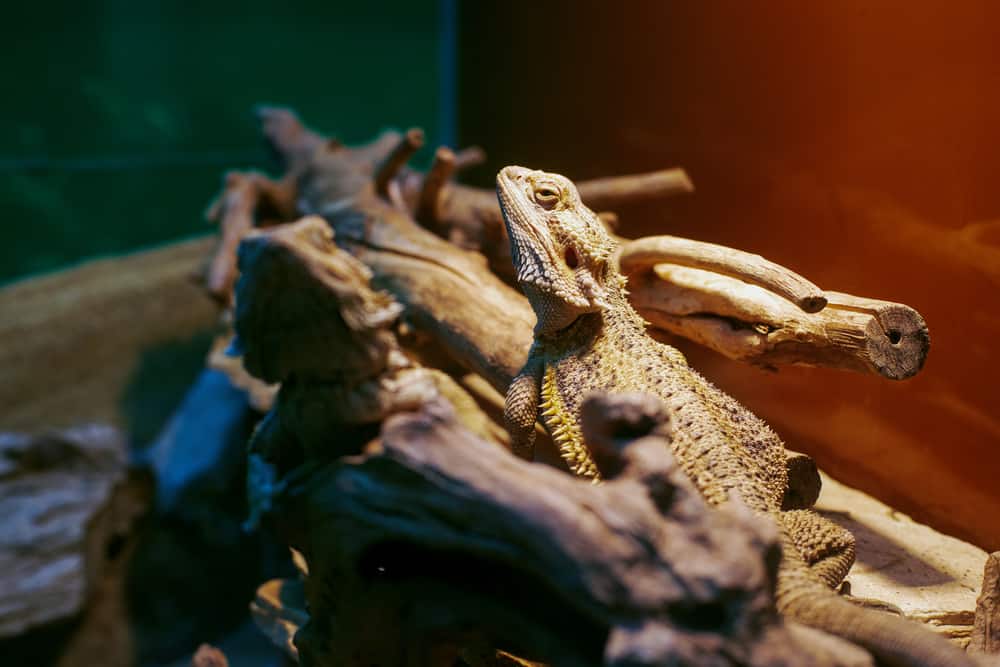
Typical basking behavior is sitting with their mouth wide open. You can use regular bulbs for the basking light source (between 40 and 100 watts).
Use UVB bulbs during the day. Don’t forget to check the level of UV output every six months with a UV meter.
Expert Tip: Ensure that lighting is on for at least 1 hour after feeding to help them digest their food.
Read more about lighting in-depth in our beginner’s guide to lighting.
Related Species and Articles to Central Bearded Dragons
Now that you’re familiar with the basics, you’re ready to read about common mistakes in central bearded dragon care.
If reading about how to give your bearded dragon the best care has left you eager for more, you can read some bearded dragon facts here.
If you’re interested in Bearded Dragons, have a look at:
- Atadenovirus – Why Is My Bearded Dragon Stargazing?
- Fancy Bearded Dragons – Everything You Need to Know German Giant Bearded Dragon Care Guide: What Owners Should Know
You can also check out our other articles on lizards – carefully written by our experienced experts!
Have you had an interesting experience with your bearded dragon? Tell us about it in the comments below!
